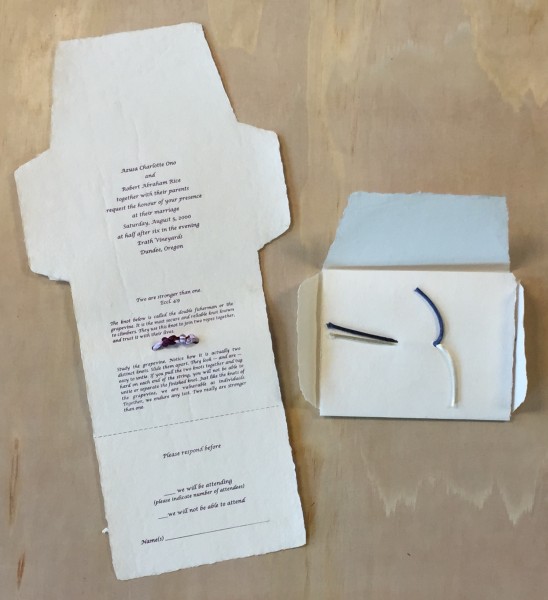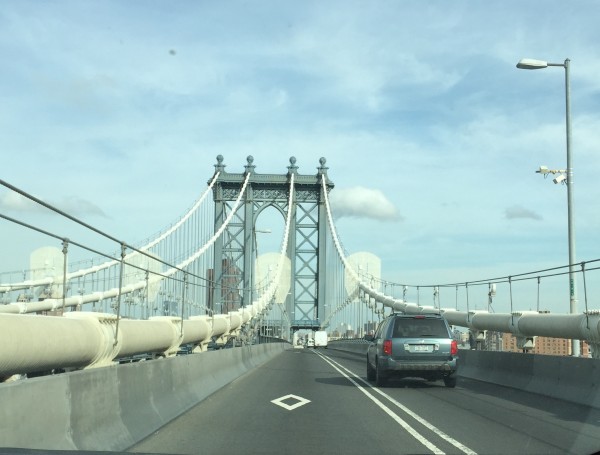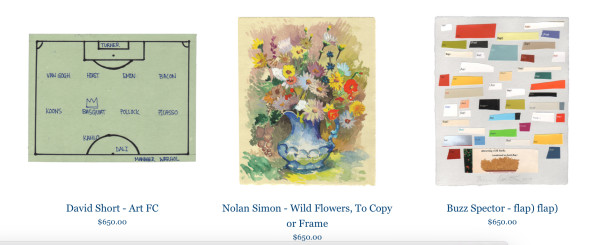Support Handmade Paper!
The Sunday Paper #75
Paper of the Week: Shaped Paper
Making shaped papers is a unique hand papermaking technique. There really isn’t any other way to get a shaped sheet of paper with deckled edges. For those of us who make paper, it is a simple way to create envelopes, hearts, circles or multiple shapes on a large deckle.

I designed this shaped deckle for my wedding invitation many moons ago. I was delighted when I figured out how to incorporate the invitation, envelope and response postcard all in one sheet of paper. In case you are reading the fine print, this is a picture of someone else’s wedding invitation – the design was popular (and economical) so it was reproduced and sold by Oblation Papers & Press for a few years.
I used to cut my shaped deckles in Artcor (similar to foam core, but made entirely of plastic, i.e. waterproof) but it is hard to find these days. I’ve resorted to using foam core and covering it with wide plastic tape to make it waterproof. You can also use 1/4″ styrofoam (sold in sheets at large hardware stores) or if you have a jigsaw, you can create shaped deckles from a thin wood, like masonite (if you use wood, I would recommend coating it with polyurethane). There are several ideas for making shaped papers in chapter 10 of my book The Papermaker’s Companion.
How do you make shaped papers?
————————————————————————————————————––––––––––––
Sponsor of the Week
From September 11 to November 20, 2015, the Robert C. Williams Museum of Papermaking presents Paper Narratives, an invitational group exhibition featuring the work of five artists: Doug Baulos, Denise Bookwalter, Kerri Cushman, Lauren Faulkenberry, and Lee Emma Running. Each artist utilizes paper as a primary ingredient to manifest their ideas. This exhibition is curated by Suzanne Sawyer. We’ll be highlighting each of the other artists in future issues of The Sunday Paper.

© 2015, Denise Bookwalter, Catching Floats in Fair Isle Knitting, screen print on laser cut paper with pins, approx 2 ½ feet x 12 feet x 1 inch
Denise Bookwalter’s work is the result of her perpetual pursuit of knowledge and understanding. As a child she realized quickly that the accumulation of information far exceeded the quantity that a dedicated classroom teacher had patience or time enough to teach. Initially, she approaches her work as a scientist approaches their research. “I first gather information from primary sources. As the search for images develops, I follow a considerably less linear path and am attracted by the unexpected and overlooked… The combination of research, information and play is the subject of my work.”
————————————————————————————————————––––––––––––
In the Studio:
I’ve been out of the studio for the past week, enjoying a burst of New York City! I made a little slide show about my trip, which you can view here.
————————————————————————————————————––––––––––––
Speaking of NYC, Dieu Donné Papermill’s benefit auction is coming up. If you don’t live in NYC and can’t make it to the event, they are making it easy to purchase art on-line. Check it out! Grab your favorite piece now and support this organization that has been instrumental in pushing hand papermaking into the 21st Century.
This is a pretty cool video of a paper robot. I like the animation style that shows both the construction of the robot and then how it walks.
Maybe paper engineering will become a field of study one day soon. I love the plethora of articles that feature technological developments that begin in paper. I don’t think this is anything new really, but it is certainly in the news more.
A cut or tear in a material is typically a sign of weakness. Now, a Northwestern University, University of Illinois and Tsinghua University research team has created complex 3-D micro- and nanostructures out of silicon and other materials found in advanced technologies using a new assembly method that uses cuts to advantage. The Kirigami method builds on the team’s “pop-up” fabrication technique — going from a 2-D material to 3-D in an instant, like a pop-up children’s book. While an innovative first step, those earlier ribbon-like structures yielded open networks, with limited ability to achieve closed-form shapes or to support spatially extended devices.
I’m not a bug lover, but these paper bugs by Qin Kun are pretty incredible.
This is a beautiful video on the making of Japan
ese handmade paper of Kyoto Kurotani.
————————————————————————————————————––––––––––––
About our sponsor: Did you know that we have a papermaking museum in America? It is Atlanta, and it is a fantastic place to visit! It is open to the public, and you can view exhibitions, take workshops and discover the amazing history of paper. For those of you who know who Dard Hunter was (if you don’t, look him up!) his collection is housed in the museum.
————————————————————————————————————––––––––––––
 If you enjoyed reading The Sunday Paper today, why not sign up to get it delivered to your in-box each and every Sunday? Click here to subscribe (it’s free), and you’ll receive my nifty pop-up alphabet template as a thank you gift!
If you enjoyed reading The Sunday Paper today, why not sign up to get it delivered to your in-box each and every Sunday? Click here to subscribe (it’s free), and you’ll receive my nifty pop-up alphabet template as a thank you gift!
If you read this blog regularly, would you consider making a donation to support the research, writing, design and delivery of The Sunday Paper? Click on that cute paper button (I made that paper) to see how you can provide support.
And if you run a paper-related business, you might be interested in promoting your business in The Sunday Paper.
Thank you to those who have pledged your support, and enjoy your Sunday!





1 Comment
Helen, I have had success making shaped papers using old foam meat trays kids and foam sheets both narrow and wide.
Thank you for all the info in the Sunday Paper.
Win